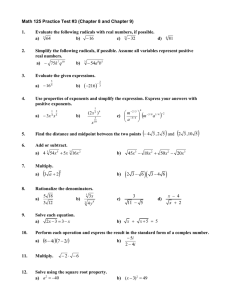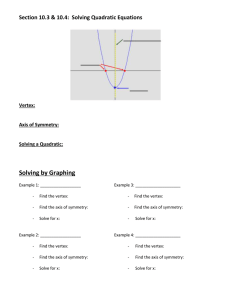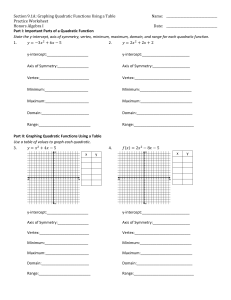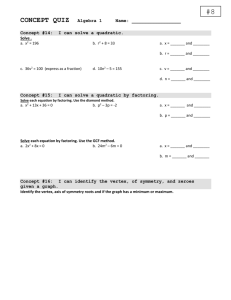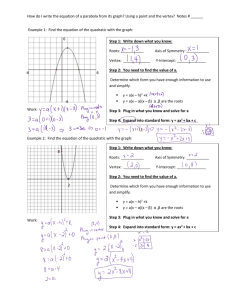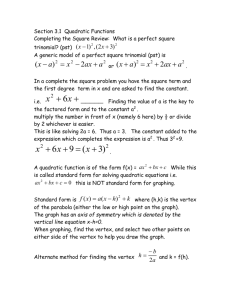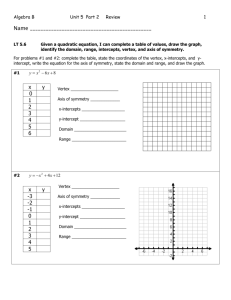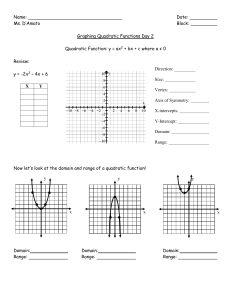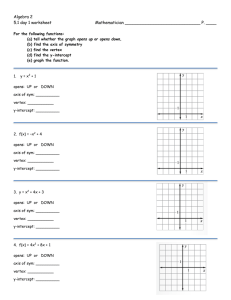Practice on Completing the Square and its uses. I. How to “complete
advertisement
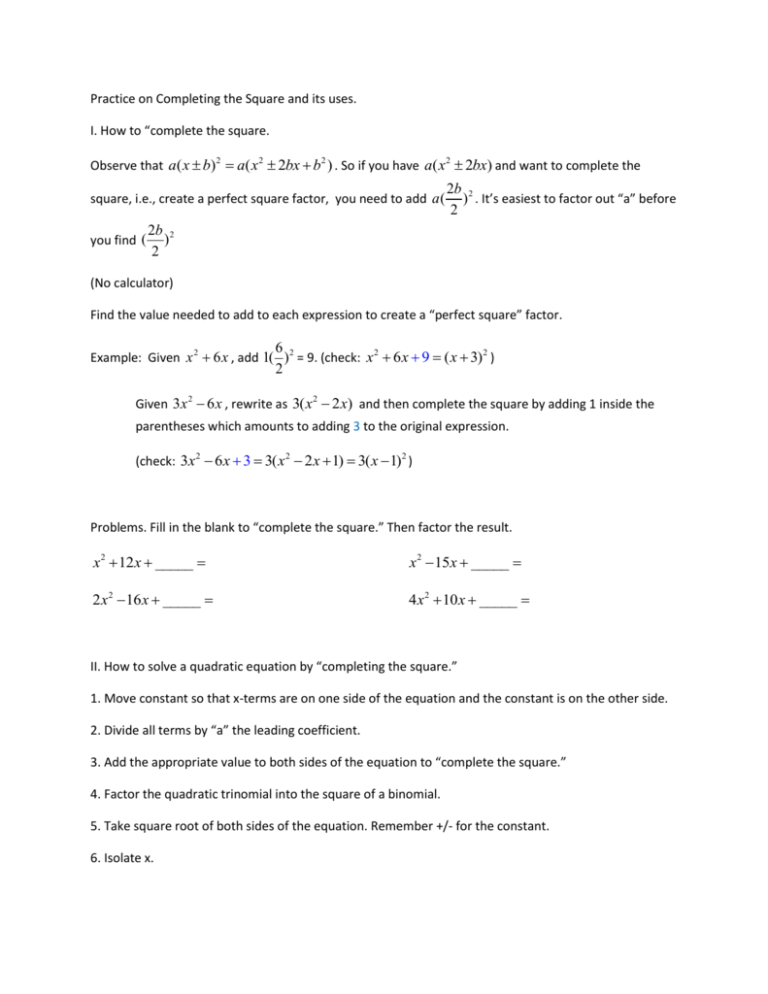
Practice on Completing the Square and its uses. I. How to “complete the square. Observe that a( x b)2 a( x 2 2bx b 2 ) . So if you have a( x 2 2bx) and want to complete the square, i.e., create a perfect square factor, you need to add a ( you find ( 2b 2 ) . It’s easiest to factor out “a” before 2 2b 2 ) 2 (No calculator) Find the value needed to add to each expression to create a “perfect square” factor. 6 2 Example: Given x 2 6 x , add 1( ) 2 = 9. (check: x 2 6 x 9 ( x 3) 2 ) Given 3x 2 6 x , rewrite as 3( x 2 2 x) and then complete the square by adding 1 inside the parentheses which amounts to adding 3 to the original expression. (check: 3x 2 6 x 3 3( x 2 2 x 1) 3( x 1)2 ) Problems. Fill in the blank to “complete the square.” Then factor the result. x 2 12 x _____ x 2 15x _____ 2 x 2 16 x _____ 4 x 2 10 x _____ II. How to solve a quadratic equation by “completing the square.” 1. Move constant so that x-terms are on one side of the equation and the constant is on the other side. 2. Divide all terms by “a” the leading coefficient. 3. Add the appropriate value to both sides of the equation to “complete the square.” 4. Factor the quadratic trinomial into the square of a binomial. 5. Take square root of both sides of the equation. Remember +/- for the constant. 6. Isolate x. 3 x 2 18 x 10 0 3 x 2 18 x 10 x2 6x 10 3 Example: x 2 6 x 9 10 37 9 3 3 37 3 37 111 x3 3 3 ( x 3) 2 x 3 111 3 Problems. Solve by “completing the square.” 1. x 2 20 x 69 0 2. x 2 7 x 21 0 III. How to rewrite a quadratic function in vertex form. 1. Move constant to “y-side” of the equation. 2. Factor out “a” from both “x” terms. 3. Complete the square. Remember to add the correct value to the “y” side of the equation. 4. Factor the complete square trinomial. Example: y 2 x 2 4 x 10 y 10 2 x 2 4 x y 10 2( x 2 2 x) y 10 2 2( x 2 2 x 1) y 12 2( x 1) 2 Vertex (-1, -12) ; Axis of symmetry: x = -1 y-intercept: (0, -10); Symmetry point of y-intercept (-2, -10) Problems. Rewrite each equation in vertex form. Then state vertex, equation of axis of symmetry, and yintercept and its symmetry point. 1. y x 2 8 x 12 2. y 3x 2 21x 6 Answers: Part I: x 2 12 x 36 ( x 6)2 2 x 2 16 x 32 2( x 2 8x 16) 2( x 4)2 x 2 15 x 225 15 ( x )2 4 2 10 5 25 5 4 x 2 10 x 4( ) 2 4( x 2 x ) 4( x ) 2 8 2 16 4 Part II: x 2 7 x 21 0 x 2 20 x 69 0 x 2 20 x 100 69 100 1. ( x 10) 2 169 x 10 13 x 10 13 3, 23 x 2 7 x 21 49 49 x2 7 x 21 4 4 7 35 2. ( x ) 2 2 4 7 i 35 x 2 2 7 i 35 x 2 2 Part III: y x 8 x 12 2 y 12 x 8 x 2 1. y 12 16 x 8 x 16 2 y 28 ( x 4) 2 y 3x 2 21x 6 y 6 3x 2 21x 2. y 6 3( x 2 7 x) 49 49 ) 3( x 2 7 x ) 4 4 171 7 y 3( x ) 2 4 2 y 6 3( Vertex (-4, 28) Vertex: (7/2, -171/4) Axis of sym: x = -4 Axis of sym: x = 7/2 y-intercept: (0, -12) y-intercept: (0, -6) Sym point: (-8, -12) Sym point: (7, -6)
